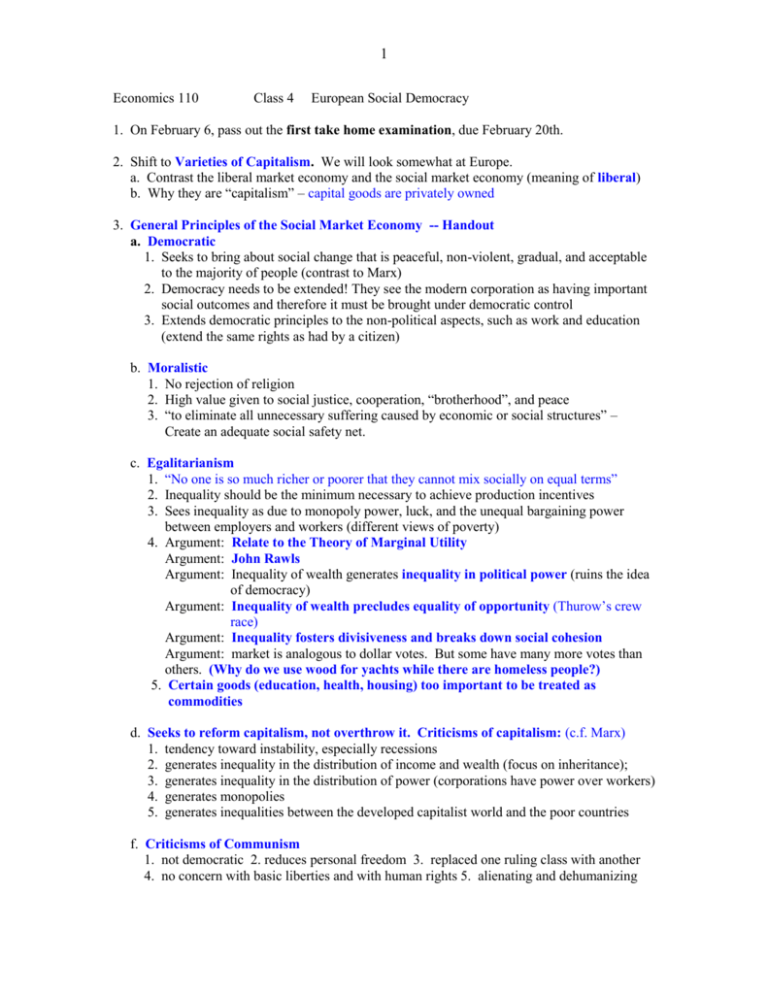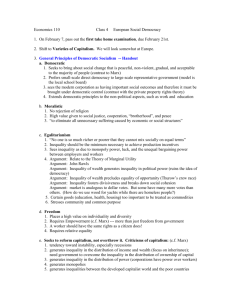Economics 110 Class 4 European Social
advertisement

1 Economics 110 Class 4 European Social Democracy 1. On February 6, pass out the first take home examination, due February 20th. 2. Shift to Varieties of Capitalism. We will look somewhat at Europe. a. Contrast the liberal market economy and the social market economy (meaning of liberal) b. Why they are “capitalism” – capital goods are privately owned 3. General Principles of the Social Market Economy -- Handout a. Democratic 1. Seeks to bring about social change that is peaceful, non-violent, gradual, and acceptable to the majority of people (contrast to Marx) 2. Democracy needs to be extended! They see the modern corporation as having important social outcomes and therefore it must be brought under democratic control 3. Extends democratic principles to the non-political aspects, such as work and education (extend the same rights as had by a citizen) b. Moralistic 1. No rejection of religion 2. High value given to social justice, cooperation, “brotherhood”, and peace 3. “to eliminate all unnecessary suffering caused by economic or social structures” – Create an adequate social safety net. c. Egalitarianism 1. “No one is so much richer or poorer that they cannot mix socially on equal terms” 2. Inequality should be the minimum necessary to achieve production incentives 3. Sees inequality as due to monopoly power, luck, and the unequal bargaining power between employers and workers (different views of poverty) 4. Argument: Relate to the Theory of Marginal Utility Argument: John Rawls Argument: Inequality of wealth generates inequality in political power (ruins the idea of democracy) Argument: Inequality of wealth precludes equality of opportunity (Thurow’s crew race) Argument: Inequality fosters divisiveness and breaks down social cohesion Argument: market is analogous to dollar votes. But some have many more votes than others. (Why do we use wood for yachts while there are homeless people?) 5. Certain goods (education, health, housing) too important to be treated as commodities d. Seeks to reform capitalism, not overthrow it. Criticisms of capitalism: (c.f. Marx) 1. tendency toward instability, especially recessions 2. generates inequality in the distribution of income and wealth (focus on inheritance); 3. generates inequality in the distribution of power (corporations have power over workers) 4. generates monopolies 5. generates inequalities between the developed capitalist world and the poor countries f. Criticisms of Communism 1. not democratic 2. reduces personal freedom 3. replaced one ruling class with another 4. no concern with basic liberties and with human rights 5. alienating and dehumanizing 2 4. Why has there been no Democratic Socialism in the United States? a. The United States does not have a rigid class structure as Europe does (inherited from its feudal past) b. In the United States, ethnicity divides the working class, not class structure c. The electoral college system makes it very hard for third parties to succeed (also the winner takes all congressional system) d. The American frontier served as a safety valve for discontent e. Americans think they have greater social mobility than Europeans (don’t) f. Americans confuse socialism with communism g. Canada, where the Tories went, is much like Europe. 5. Social Ownership (Nationalization) a. Only for some of the industries (c.f. Russia) 1. natural monopolies (electricity, natural gas, railroads, post office) 2. Industries with great social importance that cannot make profits (Public TV) 3. Industries where the government believes it can improve performance through Reorganization (airways, coal, steel) 4. to remove private economic power (banking) 5. to force companies to pursue important social purposes (health) b. Done with compensation (not expropriate) c. The Minister appoints a Board of Directors who appoint a Director 1. to be free of outside influences 2. c.f. Palomar College 3. goal is to make profits and to meet other important social purposes. If there are losses, the government provides subsidies d. Results were disappointing --- seen as excessively bureaucratic. Performance was not good and the subsidies were costly. In the 1980s, Thatcher started privatization. This has proceeded in many countries. 1. in many cases, the government monopolies have been replaced by private monopolies 2. in many of these, employment fell considerably while executive pay rose 6. Economic Planning (indicative, most strongly in France and Britain) a. to overcome the anarchy of the market (c.f. Marx) -b. The first step is information gathering The second step is that the planners consult with leading economic actors – a process called Concertation. Explain corporatism c. The 3rd step is to adjust it to assure consistency, both among the various sectors and also over time; also try to ensure policy coordination d. makes information about investment possibilities available to companies and encourages them to undertake these investments (but company behavior is voluntary) 1. need to explain investment (define) decision making -- adaptive expectations 2. need to explain the herd mentality --- use housing in San Diego as the example e. assumes the government has an advantage in information gathering and that the planners have high credibility. When the plans became incorrect, people stopped trusting the planners. Need to explain the high regard for bureaucrats in France! f. set growth targets for every sector g. The government is to support the plan by credit allocation, by tax policy, by its own purchases h. problem: the economy is subject to outside shocks that cannot be predicted – eg oil prices i. Basically abandoned in 1993. 3 7. Business a. Corporatism – participate in employers’ and trade associations b. More financing from banks and less from stockholders c. stock ownership is less widely dispersed with banks often as large owners d. means that investors are more deeply involved with the management and are long-term 8. Labor Market a. European countries have a high rate of unionization, c.f. the United States. The unions are usually well connected to a political party (Labor) 1. rates of union density on Page 7 b.. Collective Bargaining -- Corporatism --- centralized wage bargaining 1. Contrast with the United States 2. more likely to exercise restraint – no leap frogging 3. Harmonious relations (my own story) c. Solidaristic Wage Bargaining --- equalize wages across firms and across skill and seniority levels. Smaller differentials between skilled and less skilled 1. few wage differences so workers would shift easily from failing companies to better ones 2. drives weak firms out of business more quickly – cannot exist as a low wage company --- Wal-Mart 3. may force companies to try to make workers more productive 4. Became a disincentive when move to an information based economy --- need people to have incentives to invest in skill development. d. Industrial Democracy --- Germany (Co-Determination) 1. Worker representation on Boards of Directors 2. an attempt to overcome worker alienation Economic Democracy (Sweden) --- Never fully implemented 1. part of company profits must be put into a fund to buy shares of the company 2. the fund was controlled by the union 3. each fund was limited to shares representing no more than 8% of the voting rights d. to deal with the concentrated nature of ownership of capital4 e. Employment Security 1. difficult to fire or lay-off workers (France proposal 2006) 2. yields longer tenure with the same employer – greater trust and loyalty 3. companies may be reluctant to hire or may invest more in their workers This seems to 8hurt young people and women and benefit men over 25. 4. persistently high unemployment in many countries of Europe f. Active Labor Market Policies 1. most extensive program in the world for retraining workers to move from dying industrial sectors to expanding ones. 2. generous unemployment compensation – see replacement rates on Page 12 3. Germany: government-financed vocational school + apprenticeships 4. education – less dispersion around the average g. Other Policies 1. French workers put in fewer hours than others due to shorter workweeks, more holidays, and longer vacations. 1,532 hours per year. 2. statutory workweek of 35 hours starting in 2002 3. lower retirement age 4 9. The Welfare State a. Rationale 1. equality; there should be a guaranteed minimum income 2. to reduce the insecurities caused by the market 3. seen as a right of citizenship --- provide a sense of common purpose b. American welfare state programs include social security, Medicare, Medicaid, Unemployment Insurance, Disability Insurance, TANF, Public Housing (Title 8) Food Stamps, etc. c. In addition, European programs include family allowances, parental leave (18 months at 90% in Sweden – see Norway quote on Page 13), pregnancy payments, sick leave (all done in the US by employers) and funeral costs d. National Health 1. National provision, not socialized medicine (somewhat similar to an HMO) – paid from taxes 2. role of the primary care doctors and the specialists (hospital) 3. capitation fee 4. monopsony power over drugs 5. advantages a. universal coverage b. cheaper – spend a lower percent of GDP on health care with similar results c. removes the monetary connection between the doctor and patient 6. disadvantages a. long waits for some procedures e. highest % of GDP devoted to government spending at 60% in Sweden. Percent devoted to these social programs on Page 14 – much higher than in the US. f. Inequality 1. explain the Gini Index – data on bottom of Page 14 2. taxes and transfers have a greater equalizing effect in Europe 3. after taxes and transfers, amounts of poverty in Europe are close to zero g. Despite reforms, most aspects of the Welfare State have been maintained 1. has been some privatization of health care (co-payments) 10. Taxes and Tax Reform a. 40-50% of incomes paid in tax cf 30%+ in the US b. Swedish tax system on Page 15 c. High marginal tax rates. Up to 1991, in Sweden, the top marginal tax rate was 75% (may have reduced labor supply 6% to 10% -- explain the Laffer Curve) Tax avoidance and the underground economy may exceed 25% of official GDP. d. Tax wedge – 29% in the US and 50% in Europe e. beginning in 1991, marginal tax rates were lowered (the top rate to 50%) in Sweden 11. Results a. Some European countries have experienced high rates of unemployment and many people are unemployed for a long time b. Government spending and taxes, as a percent of GDP, are higher in Europe c. Economic Growth Rates 1980 to 2000 – see Page 19 data – growth rates were about the same. But growth rates have been higher in the USA since 1995. d. Standard of living (GDP per capita) – high but not as high as the USA e. Productivity is about the same – see data Page 20 f. Europeans are more energy efficient 5 g. Greater equality in Europe measured by the Gini Index – see Page 20 1. lower crime rate in Europe 2. Europe has virtually eliminated poverty e. Scandinavia has the lowest rate of wage discrimination by gender h. Economic Security i. Price Stability – inflation rates have been low and about the same as the USA 12. Thatcher Reforms for Next Week 1. privatization 2. create quasi markets in education and in health care











